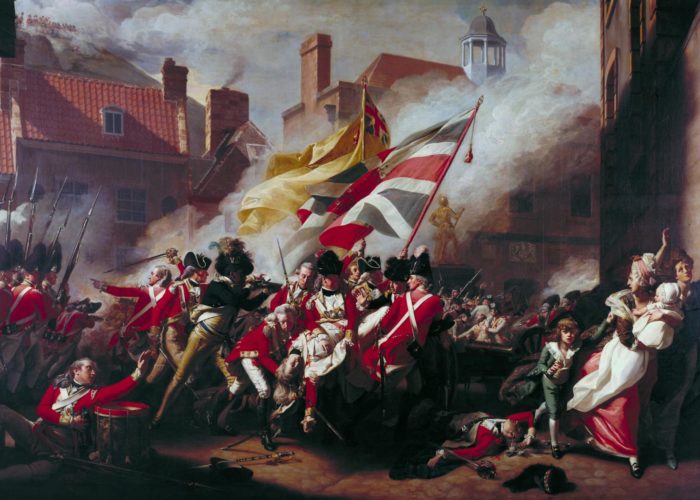The death of Major Peirson, 6 January 1781
Theme: American war of independence (1775 - 1783), American revolution, War and the international order
In 1781, France invaded the Channel Island of Jersey. It was successfully defended by the British – an important victory at a time when they were failing in their war with America (American War of Independence) and about to lose control of their American colonies. This painting celebrates the victory and commemorates the death of Major Francis Peirson and his refusal to surrender.
In 1778 the French had formally allied with the American rebels in their bid for independence, aiming to undermine British imperial power and regain territory around the globe. French forces invaded Jersey in 1781 in an attempt to remove the threat the island posed to French and American shipping. The French troops landed completely undetected as the island was busy enjoying ‘Old Christmas Night’. At dawn, the French marched to the town of St Helier where they captured the Governor of Jersey, Major Moses Corbet, in his bed and demanded Jersey’s surrender. Major Peirson took command, mustering the island’s troops and refusing to surrender.
The French were seriously outnumbered by the British and had counted on surprise in their favour. During the brief action a musket ball struck Major Peirson in the heart, killing him instantly. Almost immediately, Peirson’s servant, Pompey turned on the sniper and shot him dead. Peirson’s troops, enraged by his loss, launched a ferocious charge. The French surrendered and the invasion was over. There were losses on both sides, with the death of 15 British and 78 French soldiers and many more wounded, and hundreds of captured French soldiers were sent on to prisons in England.
Although killed in the early stages of the attack, the painting shows Peirson dying under the Union flag at the moment of British victory. At that time, Britain needed a hero and Peirson fitted the bill. His servant, Pompey can be seen at the centre of the painting returning fire. He is the only black figure and is a rare example from the time of a black man being portrayed in such a prominent and positive way. The painting drew huge crowds when it was first exhibited in 1784.
Did you know..?
The artist, Copley, modelled Pompey on a servant of the auctioneer James Christie.
Sources & acknowledgements
This object description and its related educational resources were researched and written by our team of historians and education specialists. For further information see the item’s home museum, gallery or archive, listed above.
-
Did you know..?
The artist, Copley, modelled Pompey on a servant of the auctioneer James Christie.
-
Education overview
You can access a range of teachers resources related to this object and more on our education page.
Please also see our glossary of terms for more detailed explanations of the terms used.
-
Curatorial info
- Originating Museum: Tate
- Accession Number: N00733
- Production Date: 1783
- Creator: John Singleton Copley
- Material: Oil on canvas
- Size: 2515 x 3658 mm
- Original record
-
Use this image
You can download this image for personal and educational use but please take note of the license type and rights holder information.
- Rights Holder: © Tate
- License Type:



